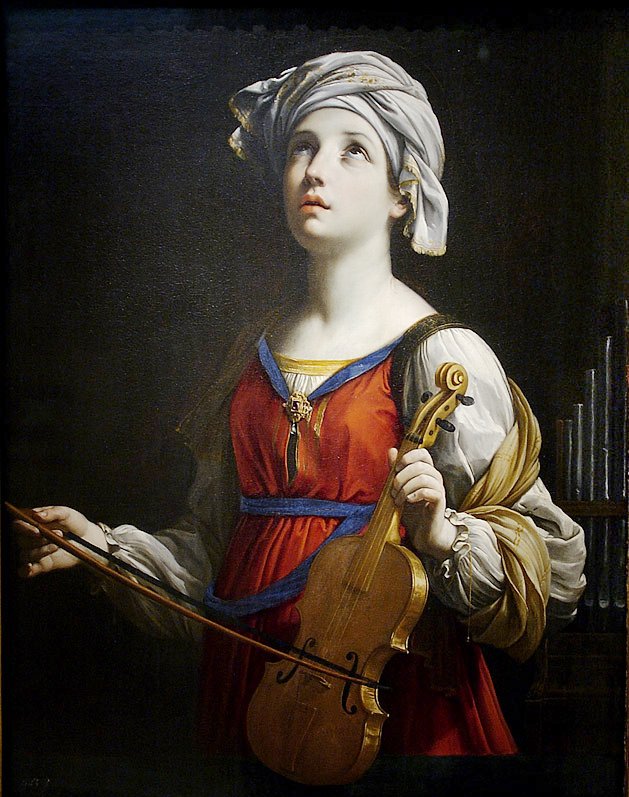Text taken from IPADRE CATHOLIC PODCASTING
English: Stained-Glass Window of Saint Perpetua of Carthage (Church of Notre-Dame
of Vierzon, France, 19th-Century). Martyrdom of Saint Perpetua and her fellows
in the stadium of Carthage. Saint Felicitas on the Left.
Français: Verrière de Sainte Perpétue (église Notre-Dame de Vierzon, XIXe siècle):
martyre de sainte Félicité et de ses compagnons; sainte Félicité est à la gauche.
Photo: 20 August 2008.
Source: Own work.
Author: Gaetan Poix.
(Wikimedia Commons)
The Second List of Saints, in The Roman Canon, follows The Consecration and Prayer for The Deceased. We sought the intercession of The Saints before The Consecration, and Prayed for our brothers and sisters who have gone before us, and once again turn to our brethren in Heaven, who await our arrival.
In The First List of Saints (just prior to The Consecration), we only have men mentioned. The Second List (after The Consecration) represents The Seven Orders, The States of Life, and Personages in The Church.
Saint Agatha, in prison,
attended by Saint Peter and an Angel.
Artist: Alessandro Turchi (1578–1649).
According to an early Christian legend, when a 3rd-Century Roman Official of Sicily desired
the Christian woman, Agatha, and she refused to yield to his advances, he had her tortured,
and even ordered her breasts cut off. At night, in prison, she was visited by a vision of
Saint Peter and an Angel, and her breasts were miraculously restored.
Date: Circa 1640-1645.
Current location: Walters Art Museum,
Baltimore, Maryland,
United States of America.
Credit line: Acquired by Henry Walters before 1909.
Source: Walters Art Museum.
(Wikimedia Commons)
The Second List begins with John the Baptist. John, The Forerunner of Christ, represents The Prophets of The Old Testament and leads to The Promised Messiah.
Then follows, in succession:
Stephen, the first Martyr of The Church, from The Order of Deacons;
Saint Matthias, who replaced Judas, the betrayer, represents The Apostles;
Saint Lucy.
Artist: Francesco del Cossa (1436–1487).
Date: After 1470.
Current location: National Gallery of Art,
Washington, D.C., United States of America.
Source/Photographer: Digital photo by User:Postdlf.
(Wikimedia Commons)
Barnabas was a Levite and a Jewish convert to The Faith, one of the earliest Disciples from Jerusalem;
Ignatius was the third Bishop of Antioch. He was among The Apostolic Fathers and a student of Saint John the Apostle (the Evangelist). Tradition tells us that Ignatius was one of the children that Jesus held and Blessed and said: “Let the children come unto Me";
Saint Agnes.
Artist: Massimo Stanzione (1586–1656).
Date: 1635.
Current location: Museu Nacional d'Art de Catalunya, Barcelona, Spain.
Source: Museu National d'Art de Catalunya, Barcelona, Spain.
(Wikimedia Commons)
Felicitas and Perpetua were both married and suffered greatly at Carthage. They were confined to a dark prison and were scourged and beheaded in the year 202 A.D;
Agatha, Lucy, Agnes, and Cecilia, represent The Order of Virgins;
Saint Cecilia
(Latin: Sancta Caecilia).
Artist: Guido Reni (1575–1642).
Date:1606.
Current location: Norton Simon Museum,
Pasadena, California,
United States of America.
Source/Photographer: http://www.wga.hu/
(Wikimedia Commons)
Anastasia represents The Widows. She was treated cruelly by her pagan husband. After his death, she lived a life of Charity and Mercy. Anastasia was burnt to death on The Feast of The Lord’s Nativity, in 304 A.D., in the reign of Emperor Diocletian.
The Second List of Saints in The Roman Canon were all highly esteemed people of Rome. Although they may not appear to relate to us today,, they represent every walk of Christian Life. Both men and women give the example that all are strong in The Grace of Christ.
Anastasiakapelle
(Chapel of Saint Anastasia),
Kloster Benediktbeuren,
Bavaria, Germany.
Illustration: PINTEREST
We seek the friendship of these Apostles and Martyrs, promising to share in their labours, sufferings and battles in our daily offertory. In The Mass, we Pray: “May the Lord accept your sacrifice and ours.” We may not physically take on The Cross or be flogged, but we willingly unite all of our sufferings with Christ The Pascal Lamb as His faithful servants with all The Saints and Martyrs, both named and unnamed, to spread the saving Gospel of Christ.












